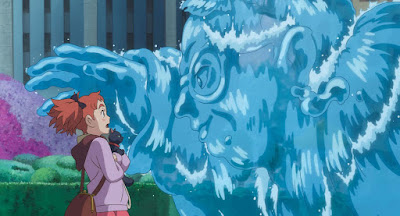The Verge has an excellent interview with Studio Ponoc founder (and former Studio Ghibli producer) Yoshiaki Nishimura and director Hiromasa Yonebayashi (When Marnie Was There) about their latest venture, the animated fantasy feature Mary and the Witch's Flower. They discuss the movie, the studio's founding in the wake of Ghibli's sabbatical, and their future plans together.
Here is a short sampling of that interview. You can read the complete article at The Verge.
What was the process like of bringing Studio Ponoc together?
Yoshiaki Nishimura: This was a very difficult, tough three years for us. We were at Studio Ghibli until the end of 2014. And then two and a half years later, we had to complete a feature film, starting from zero, basically. And the two main difficulties were that we didn’t have the Studio Ghibli brand name, because our new studio was not known, and so trying to collect the financing was difficult. We had to work with a rather low budget. And at Studio Ghibli, there were 150 to 200 creators with the wonderful environment, with hardware, software, computers, servers all set up in the production studio itself. Whereas we had to start from zero, and build up that environment and equipment for our production.
We started with two to three people. But by the end, we were 450 creative people working on the film. Within these limitations, we had to aim for the quality and meaningful content similar to films Studio Ghibli had made. That was a very tough bar for us to accomplish.
Why this particular story? What was the draw?
YN: In order to make this first film for the studio, we thought it would be best to make a film that was quite the opposite from When Marnie Was There, the last film director Yonebayashi made at Studio Ghibli. When Marnie Was There is about a quiet girl in interior struggle. It’s a very calm movie. But the special talent director Yonebayashi has, that he gained from director Hayao Miyazaki at Studio Ghibli, is drawing dynamic action as an animator. So the idea was to have a very energetic girl moving around in a very fantastic way in a fantasy world. So the topic we chose was a witch.
I read many children’s books and young adult books to search for projects to film. Many of those — when a witch character faces difficulty — they use magic to solve the problem. The Little Broomstick was the only story I saw where the heroine rejects magic at a crucial point, at the most difficult point. The quote from the book is something like, “I’m not going to use magic to open this door. I’m going to use my own powers. However long it may take, I’m going to do it on my own.” I thought that would be wonderful for the first concept of the film, because we have left the magic umbrella of Studio Ghibli, and now we have to walk with our own strength and power. So this fits the situation that director Yonebayashi and I as producer and other former Studio Ghibli creators faced as well.
What’s next for Studio Ponoc? Are you are you planning on making more films that look and feel like Studio Ghibli? Does the studio want to branch out further?
YN: One thing I learned from director Takahata is that the content decides what kind of expression to use. If you only have one form of an expression, it just becomes a style, rather than a fit with the content. So it depends on what kind of material we’re dealing with, as to what kind of expression and style we end up showing. Our heritage from Studio Ghibli makes us very strong believers in 2D animation. But it’s not that we reject 3D animation. There may be some content that would be good for a kind of fusing of 2D and 3D animation.
At Studio Ponoc, we are working on four short films right now. One is being directed by director Yonebayashi, and there are three other directors working on the other shorts. But we also are determined to continue making feature-length film. And for us, the heroes and heroines are the children we are making the films for. We want to continue to make films that both children and adults can enjoy watching together. That is our mission, and that’s what we have brought forward from our experiences.


No comments:
Post a Comment